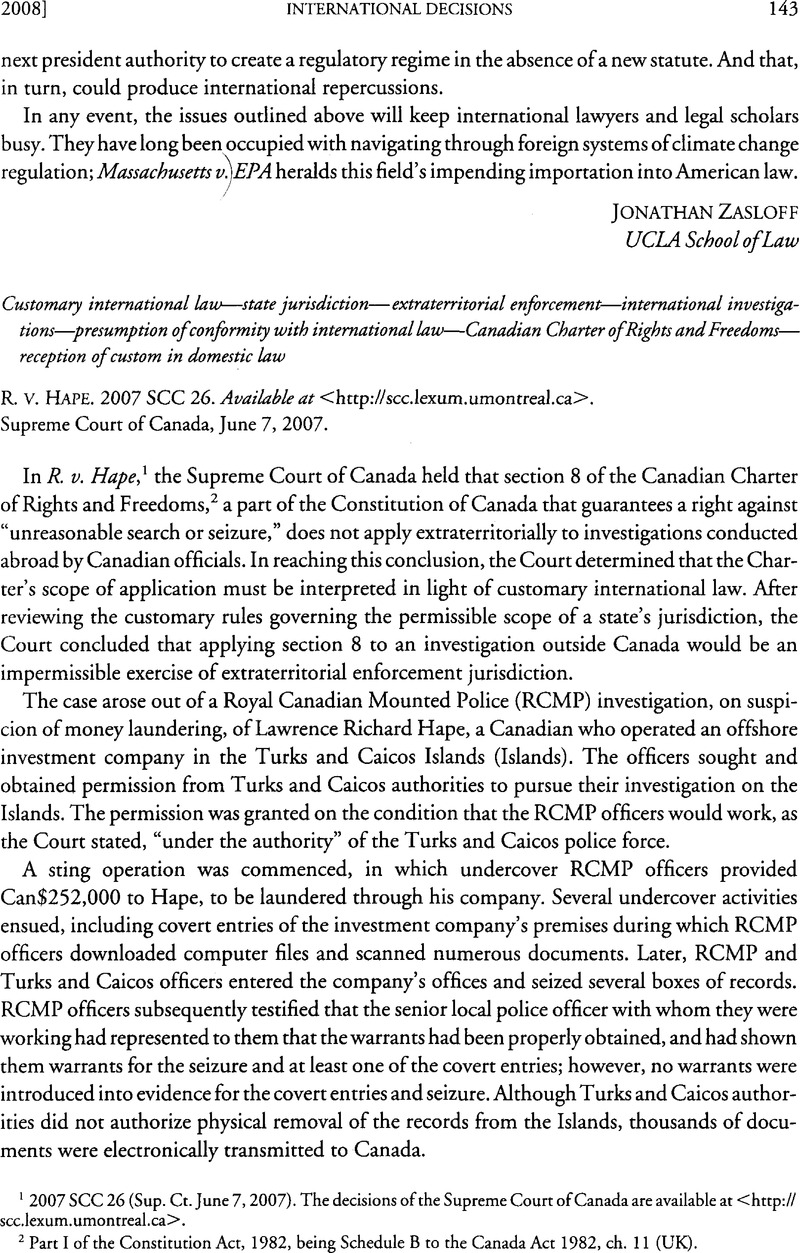No CrossRef data available.
Article contents
R. v. Hape
Published online by Cambridge University Press: 27 February 2017
Abstract

- Type
- International Decisions
- Information
- Copyright
- Copyright © American Society of International Law 2008
References
1 2007 SCC 26 (Sup. Ct. June 7, 2007). The decisions of the Supreme Court of Canada are available at <http://scc.lexum.umontreal.ca>.
2 Part I of the Constitution Act, 1982, being Schedule B to the Canada Act 1982, ch. 11 (UK).
3 The Court also discussed other bases of jurisdiction in international law, including universal jurisdiction (para. 61).
4 R. v. Cook, [1998] 2 S.C.R. 597; see also R. v. Harrer, [1995] 3 S.C.R. 562; R. v. Terry, [1996] 2 S.C.R. 207; R. v. Canada (Attorney General), [1998] 1 S.C.R. 841 (precedents analyzing extraterritorial application of the Charter to evidence-gathering abroad).
5 Section 7 of the Charter provides: “Everyone has the right to life, liberty and security of the person and the right not to be deprived thereof except in accordance with the principles of fundamental justice.”
6 In particular, section 24(2) of the Charter contemplates the exclusion of evidence obtained in violation of Charter rights.
7 See Gibran Van, Ert, Using International Law in Canadian Courts 137-70 (2002)Google Scholar; Jutta, Brunnée & Stephen, J. Toope, A Hesitant Embrace: The Application of International Law by Canadian Courts, 2002 Can. Y.B. Int'l L. 3 Google Scholar.
8 Restatement (Third) of the Foreign Relations Law of The United States §403 (1987).
9 Leading doctrinal sources cited by the majority do not directly support this holding. See Michael, Akehurst, Jurisdiction in International Law, 1972-73 Brit. Y.B. Int'l L. 145 Google Scholar; Mann, F. A., The Doctrine of International Jurisdiction Revisited After Twenty Years, 186 Recueil Des Cours 9 (1984-III)Google Scholar.
10 It would be otherwise if Canadian law expressly mandated acts prohibited by local law, which was not the case here. See Mann, supra note 9, at 45-46.
11 The question then would have become whether, under Canadian constitutional law, Hape could reasonably expect to enjoy the full benefits of section 8 after deliberately organizing his company and conducting its activities abroad.
12 See Slaight Commons, Inc. v. Davidson, [1989] 1 S.C.R. 1038,1056 (Dickson, C.J.) (citing Reference re Public Service Employee Relations Act (Alta.), [1987] 1 S.C.R. 313, 349 (Dickson, C.J., dissenting)).
13 See, e.g., Hunter v. Southam, Inc., [1984] 2 S.C.R. 145, 156.
14 See, e.g., Reid v. Covert, 354 U.S. 1 (1957).
15 United States v. Verdugo-Urquidez, 494 U.S. 259 (1990).
16 Unlike the U.S. Supreme Court, the Canadian Supreme Court seems to have attached very little significance to the accused's citizenship and other links with Canada.




